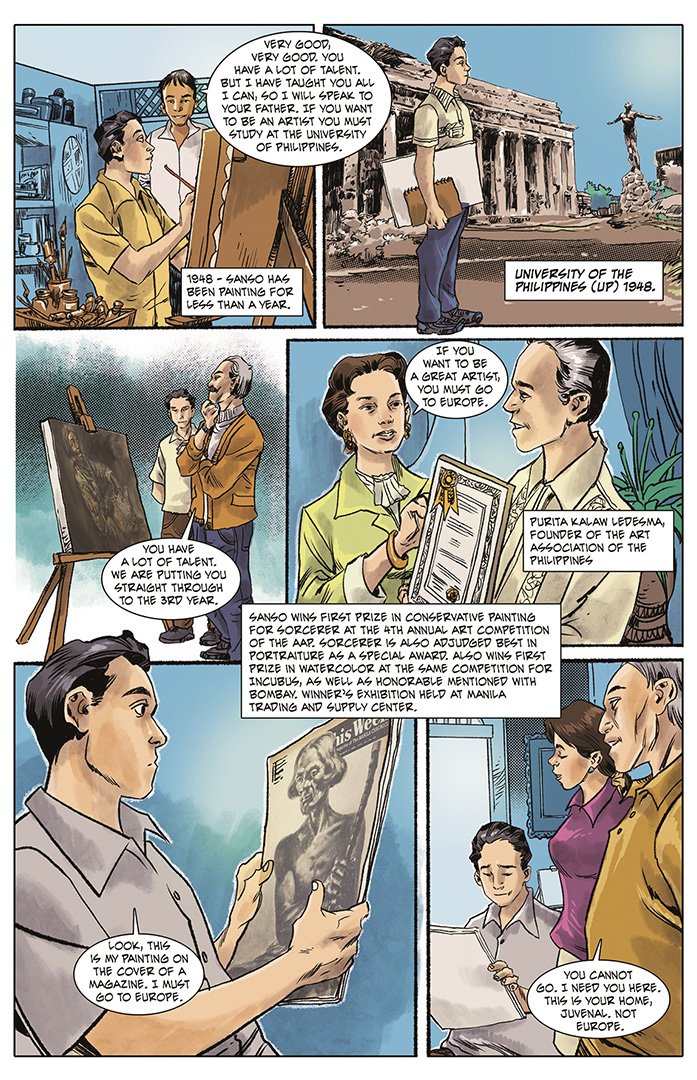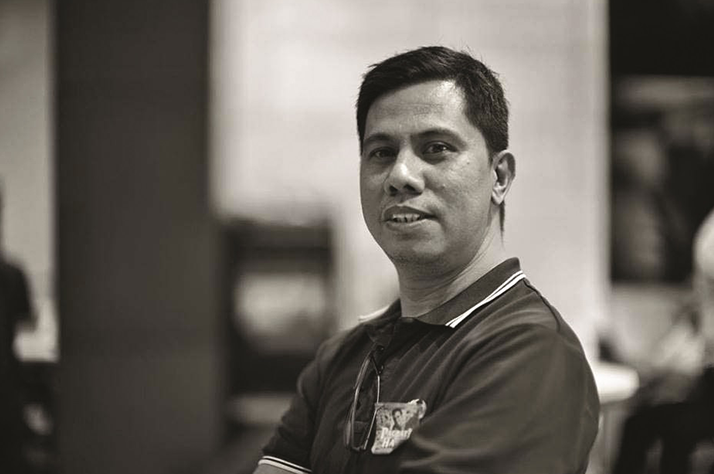Sansó, the Graphic Novel
Juvenal Sansó is one of the most important figures in modern Filipino and Spanish art. Recognized internationally, he has exhibited and won awards across the globe. His life has been extensively documented through his own artworks and the books written about his career. His life is now being explored again through a new medium: the graphic novel. Commissioned by Jack Teotico, after being pitched the project by Thomas Patrick and JV Tanjuatco, the graphic novel of Sansó’s life is set to introduce his extraordinary life and work to a wider audience.
Starting with Sansó arriving in the Philippines with his family, the graphic novel traces his survival of the Japanese invasion, learning to paint in the Philippines and abroad, and his path to becoming the world-renowned artist he is today.
Speaking about the project, Jack Teotico said: “Juvenal Sansó is an icon and trailblazer in the art scene—not only in the Philippines, but around the world. His work is in the collection of over 40 museums, and he has received either a knighthood or medal of distinction in all three countries he has lived lengthily in.
These included receiving the King’s Cross of Isabella awarded by the King of Spain, the rank of Chevalier from the French government, and the Presidential Medal of Merit award from the Philippines.
In the field of art, he has proven to be one of the best modern masters of his era. There is a need to promote his legacy and to continue educating and informing the public about his life and his works.
Aside from the books and periodicals they have produced about Sansó, Fundacion Sansó, in cooperation with Galerie Joaquin, thought that coming up with a biography of his eventful and accomplished life in the form of a comic book would be an important way to introduce him to an even larger audience.
Especially since Sansó has revolved in the field of visual arts, these comics would be a fitting visual illustration of what he has done and accomplished.”
The graphic novel was edited by JV Tanjuatco, owner of Comic Book Lab; written by Thomas Patrick, in collaboration with Fundacion Sansó museum director Ricky Francisco; and was drawn, inked, lettered, and colored by Randy Valiente. Sansó is set to be released in the first quarter of this year.
We spoke to JV Tanjuatco and Randy Valiente about how the comic book came about and learned more about their respective careers in the comic industry.
Randy Valiente
Please tell us about your background and how you became a comic artist.
I grew up in the 80s and 90s when komiks was one of the biggest industries in the Philippines. I was inspired by the stories and drawings and wanted to become a komiks artist someday. I am a product of a komiks illustration workshop in 1988 when I was in high school. In the early 90s, I got my first work published and went on to have a long career since then.
What were your biggest challenges in drawing the Sansó comic?
The depiction of time on each panel. I had to look for old photographs as references because the story depicts different decades. At first, I had thoughts on the likeness of the characters, that it should be carbon-copied, but I decided to show my style to make it more dynamic. I don’t copy or trace the faces of the characters. I just stare at the photograph of their faces long enough for me to absorb their features from different sides—front, side, quarter view.
What was your favorite scene to draw?
Old Manila, actually. There are not many outdoor scenes of Old Manila in the story, but I was so excited to look for photographs on the Internet and learned some history about the city. I also enjoyed drawing the studio scenes where Sansó is painting or talking to someone. I like drawing those art materials and stuff.
Did you find Sansó’s story relatable in any way?
Yes, as an artist, I am very inspired by his story. I know Sansó, saw his paintings before, but it’s the first time I learned about his life. I am still in awe. His works are inspiring.
How would you describe the current Philippine comic book scene?
It’s not as big as before, like compared to the 70s and 80s, when publishers came out with millions of copies every week (not every month like American comics do). But it’s getting recognition again. The generation now of comics readers is also very different from the past. Even comics, it’s not a cheap disposable entertainment like before. Now it’s more on the literary and art side of recognition. The internet also changed the game for Filipino comic creators. We don’t do comics now just for local readers, but also for international audiences. The playing field is so big now that there is a potential that Philippine comics could compete with what the Japanese or Korean produce.
JV Tanjuatco
Please tell us about your background and how Comic Book Lab came about.
I used to work in the Business Development Office in Meralco. I decided to leave to pursue a career as a comic book writer. I took an intensive workshop called Comic School Manila that was taught by Tintin Pantoja and learned all the skills required to not only write a comic, but to publish one as well. Originally, my plan was to send samples of my work to US publishers like Marvel and DC, but I realized that it would take a while before I was hired and I wanted to already earn from my newfound skills. That’s when I came up with the idea for Comic Book Lab, a business to offer comic book-creating services to clients.
How did the Sansó comic come about?
My former officemate Thomas Patrick brought the project to my attention and we presented our services to Fundacion Sansó. They were very interested in telling Sansó’s life story in the graphic novel format and signed us up for the project. We showed a portfolio of our past projects and the one art style that resonated with them was the pages of Randy Valiente. As luck would have it, Randy was available for the comic. I recommended Thomas to be our writer because I knew he was a very capable writer and he had very close connections to Fundacion Sansó. Once we had Thomas’ script approved, we commenced work. As editor for this project, there was a very organic synergy to developing the Sansó graphic novel.
Why does Sansó’s story work so well for the comic book genre?
Sansó has a very interesting backstory that is dramatic and highly visual—moving from Spain to the Philippines, surviving the horrors of World War 2, and traveling to Europe to pursue his calling as an artist. Plus, of course, his amazing paintings! Our hope is that we communicated this in our storytelling, how his own life has influenced and inspired his art.
How would you describe the Philippines’ comic book scene?
It’s at a highly creative phase! Thanks to the pandemic, many Filipino creators found the time to develop new stories! Add to that, creators are being inspired by the recent Trese Netflix show and the push from such organizations like Komiket and Penlab for new comic book content. New graphic novels are now being published at a fast rate!





